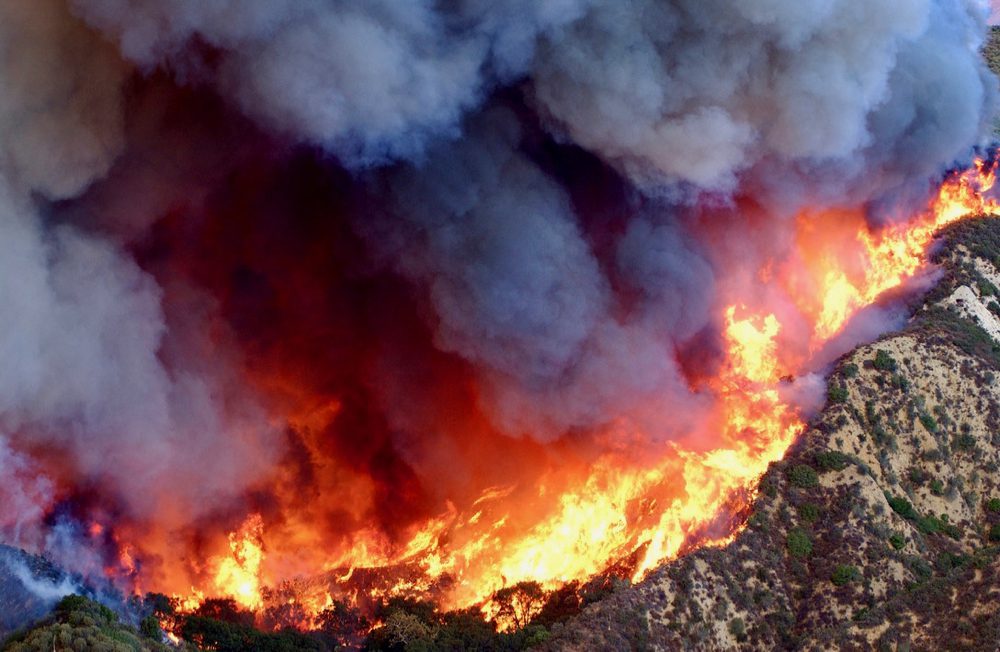
Today, Nov. 1, Santa Rosa writer, artist and teacher Dianne Monroe celebrates her 68th birthday with renewed commitment to offer the best of her gifts in this time of climate chaos and uncertainty. This week, for the second time in two years, she and her husband had to evacuate their home due to wildfires, fueled in part by human-created climate change.
As part of this commitment, and to honor the fact that her house has so far remained untouched by the fires that rage throughout California when so many others have not, she shares a piece she wrote after her first evacuation in 2017. That was when Santa Rosa was devastated by the Tubbs Fire, one of seven that burned much of Northern California during October of that year. Considered at the time to be the most destructive wildfire in California history, that fire destroyed more than 5,600 structures and killed at least 22 people. A year later, its destructiveness was surpassed by the Camp Fire.
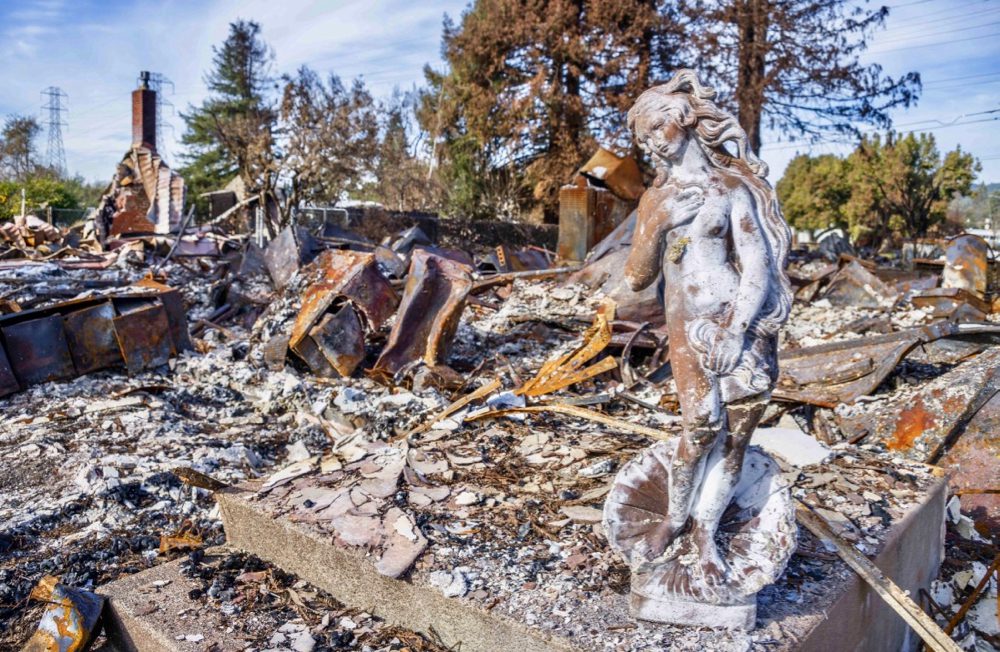
Anthropocene: relating to or denoting the current geological age, viewed as the period during which human activity has been the dominant influence on climate and the environment.
The call came a little before 5 am, the morning of Monday, October 9. I stumbled toward the phone and retrieved the message.
A neighbor’s voice, “Get ready to evacuate!”
Huh?
A quick look at the computer reveals the firestorm that began the night before in a neighboring county, moving through the night, across mountains, east to west, propelled by 60 mile per hour winds, already burning through entire neighborhoods, headed in the general direction of our home.
My husband bangs on doors in our neighborhood, awakening those who are not already awake. He pulls out the hand-crank radio I had just bought, turns it to a local station, puts on water for tea.
I start piling things into cars, working in concentric circles of necessity – important papers, medical needs, cat food and litter (the cat in her carrier will go in the car when we do), hastily packed toiletries and clothes, photos, hastily selected memorabilia – all urgently tossed into bags and bundles.
Shortly after I begin packing the lights go out. Fortunately, I know exactly where my camping headlamp and a lantern are. I stumble in the dark until I reach them, then continue cramming things into our cars.
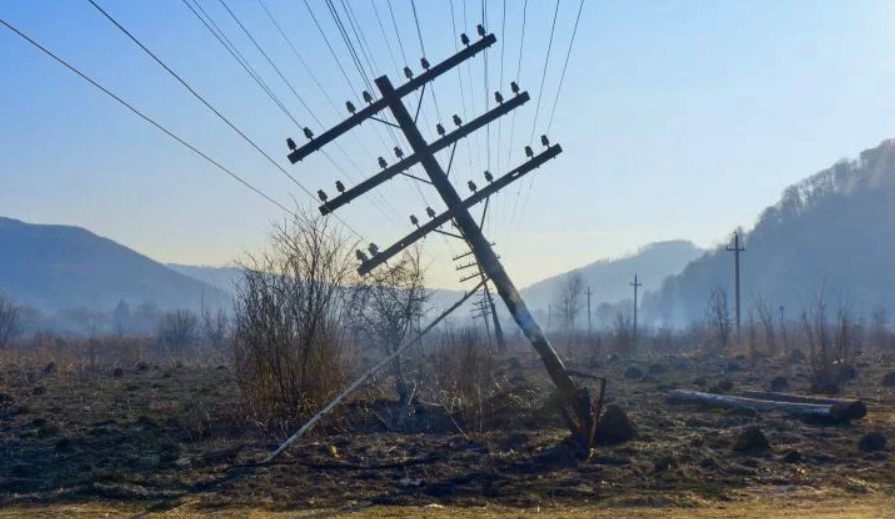
Outside is a dense smoky fog. Floating down from the night sky is something like a cinder rain. Cinders, some larger than my hand, are falling gently to the ground. I catch a couple in outstretched palms, like a child catching snowflakes, then return to my packing. Later, I will think, “If any of those cinders had still been on fire…”
The sun rises slowly – a deep red sphere in a salmon grey sky.
Evacuation
Our neighborhood is close to, but not within, an official evacuation zone. We decide to evacuate anyway, and “avoid the rush”. We head to a friend’s home in the neighboring town of Sebastopol, about 5 miles west of Santa Rosa.
As we are leaving, I pause to kiss the side of our home, feeling for a moment the enormity of the possibility that I may never again see anything that is left inside.
For more Esperanza Project coverage and analysis on causes and responses to the current plague of wildfires, click here.
The fires will burn to within a couple of miles of our home. We are much more fortunate than so many others.
We return to our home the next day. The fires are still burning, yet they are no longer traveling toward our house. The sky is a smoky grey. Air filter masks are ubiquitous everywhere in Santa Rosa – like some kind of new, dark-themed fashion craze.
We keep our cars packed – as do many of our neighbors. At night we sleep with our smart phone by our heads. We’ve signed into a service that lets us know whenever a new alert is issued. For several nights our sleep is regularly broken by the pinging sound of a new alert.
For about two weeks after the fire, I will be unable to sleep through the night. I jolt awake in the early morning hours feeling that I smell smoke, long after the smoke has dissipated from the air. I toss and turn, trying one deep breathing practice after another, until sunrise lightens the sky outside my window.
A large part of our county, along with parts of several neighboring counties, has experienced a collective trauma. There are so many whose stories are worse than mine, so many who have suffered much greater loss.
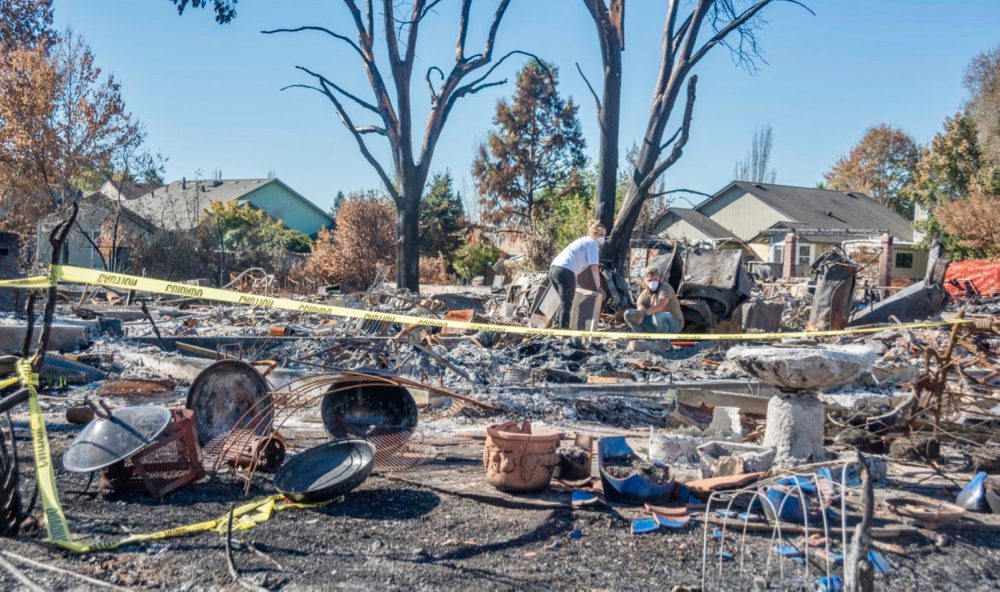
Over One Terrible Night
Over one terrible night the physical and social landscape of our county was ripped apart – and will likely never be the same.
What will happen to those homeowners unable to afford the rebuilding costs that inevitably insurance won’t cover? What about the renters whose homes burned – in an area where housing is among the most expensive and least available in the country? Will they be pushed into homelessness, forced to try to move elsewhere? What will happen to all the people working paycheck to paycheck whose workplaces were destroyed in the fire? Will they meet the same fate? What will happen to the vineyard workers (many of whom are undocumented), whose work undergirds the tourism industry, from which many in our county directly or indirectly earn their living?
What will be the immediate and long-term impact of the giant hole ripped in the fabric of our ecology, economy and social functioning? How many personal tragedies will take place unseen and uncounted, long after the cameras and news teams have left?
Our community is generous and smart. Everywhere there are fundraisers – with an emphasis on those whose needs are greatest, especially the undocumented. Ecologists and permaculturists (abundant in our county) are urgently working on issues of soil and groundwater contamination (so many toxins are released when urban areas burn), and urging city and county authorities to consider more ecological approaches to rebuilding.
How the rebuilding will happen is a story still being written. Yet the questions hang in the air, like the smoke from the fires that until recently blanketed our area.
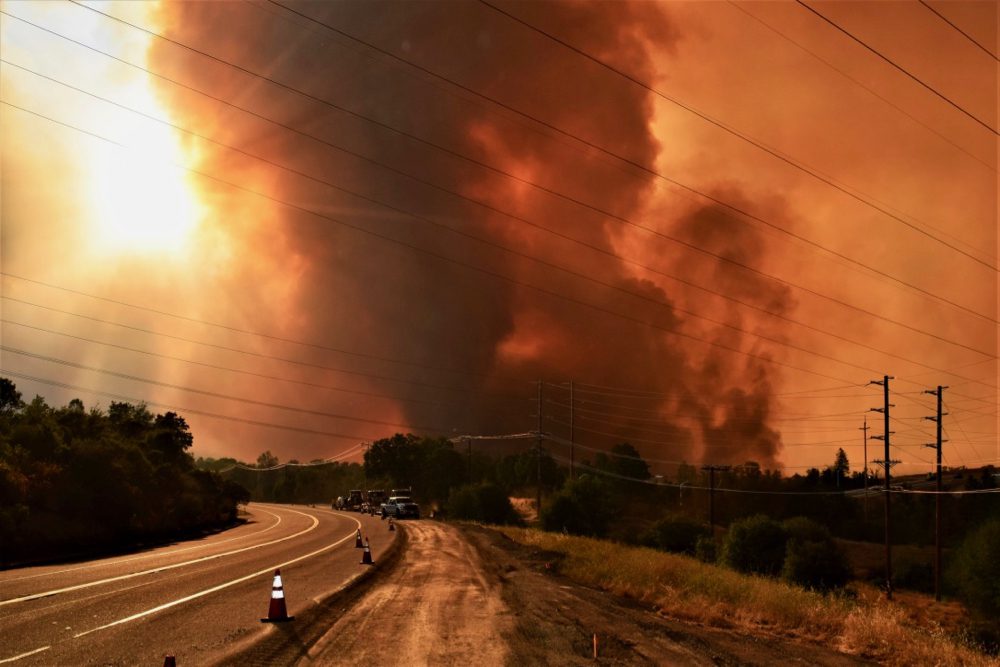
Things Fall Apart
Everything seems to be moving faster. In the weeks before these fires, we watched three supersize hurricanes decimate first Houston and surrounding areas (Harvey, Aug 17 – Sept 3); then large parts of the Caribbean, including Puerto Rico, and southern Florida (Irma, August 30 – Sept 16), then a second devastation of Puerto Rico and large parts of the Caribbean (Maria, Sept 16 – Oct 3).
Hurricanes and wildfires are not new – yet the ferocity and destructiveness of these hurricanes and our fire were fueled by conditions rooted in climate change.
All this, overlaid by the tsunami of the Trump regime (recognizing that Trump is the figurehead of the problem, and not the root of an extreme-right authoritarianism spreading across our globe).
How many people worry about the loss of their health insurance, while at the same time losing their home and/or work in one of these climate change fueled disasters? How many “mixed-status” families (with one or more undocumented members) live in fear of their families being torn apart by deportation, while also suffering the loss of home and/or work in one of these climate disasters?
What happens when (or as) things start unraveling so fast that more and more people, families, communities begin to crumble under the combined weight of multiple tragedies?
In this article, I am speaking about the pace of disasters within the U.S. This is amplified and magnified by multiple other fires, floods and other climate change related disasters around our globe.
It feels a bit like the words of William Butler Yeats poem The Second Coming:
“Things fall apart; the centre cannot hold;…
the blood-dimmed tide is loosed, and everywhere
the ceremony of innocence is drowned;”
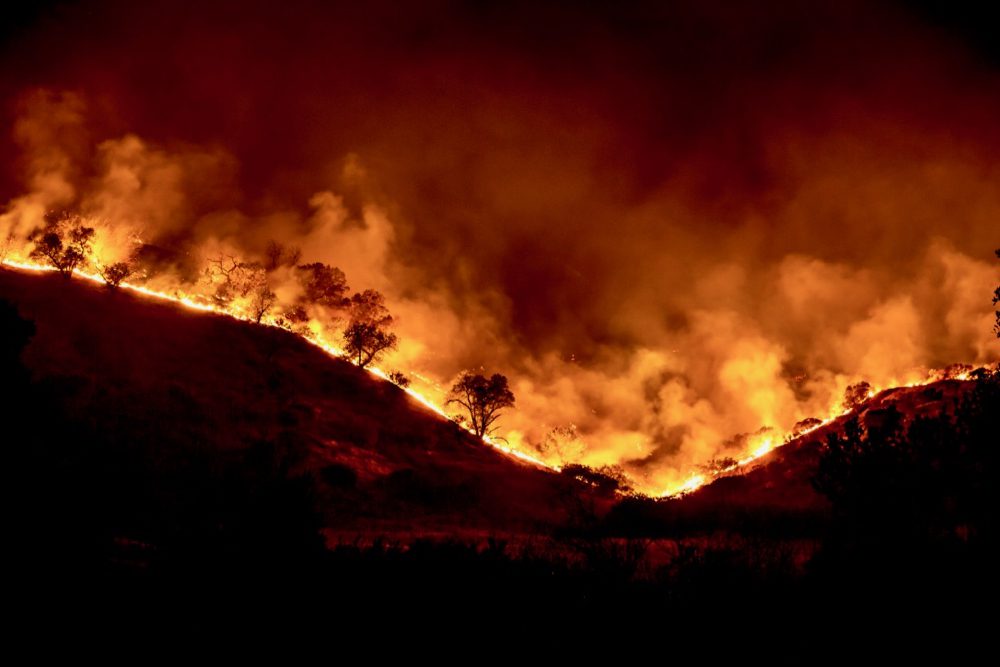
Welcome to the Anthropocene
I’ve known about the dangers of human created climate change for more than a couple of decades. (Others were aware of this far sooner than I). For several years I’ve felt that the direct impacts of human created climate change were being felt NOW – that this was no longer an issue for sometime in the future. (Again, others were aware of this sooner than I.)
I’ve known this in my head and my heart, grieved deeply about this, and tried my best to do what I could to share my understanding with others, seek ways to slow its progress and mitigate its impacts.
Yet somehow I never really felt this looming danger would leap up to bite ME. It’s a human response, I suppose, to feel that a disaster can happen to others, but not oneself. Realizing otherwise – I mean deeply realizing this in your gut (as has just happened to me) – tends to shift the ground underneath one’s feet.
It’s a knowing, not just in your head but in your gut, that everything can change in one night, riding on a gust of wind. It’s coming to really know that I (and we) live in the age of the Anthropocene – human created climate change – and our lives are not going to be the story we are told to expect.
A couple of weeks after the fires, I took a long walk along a creek in the rural area directly west of our home (which is located on the far western edge of Santa Rosa). Everything was beautiful and green in the early fall; tree leaves just beginning to be touched by gold and crimson. Ducks and egrets moved lazily in the creek, hawks sailed overhead.
Along the path, I could see the fallen black cinders, some small and some large. What if one had still been hot enough to ignite the underbrush? Could our community have been trapped between two fires, as happened to other neighborhoods in our area?
Yet as I wandered along the creek, I felt a deep sense of calm grow within me. Now I knew, not just in my head, but viscerally, in every cell of my body, that life as one knew it could be snatched away in a moment. I lived in a time when everything seemed to be speeding up, and the only thing I could do was live in it as best I could. I welcomed myself to life in the Anthropocene.
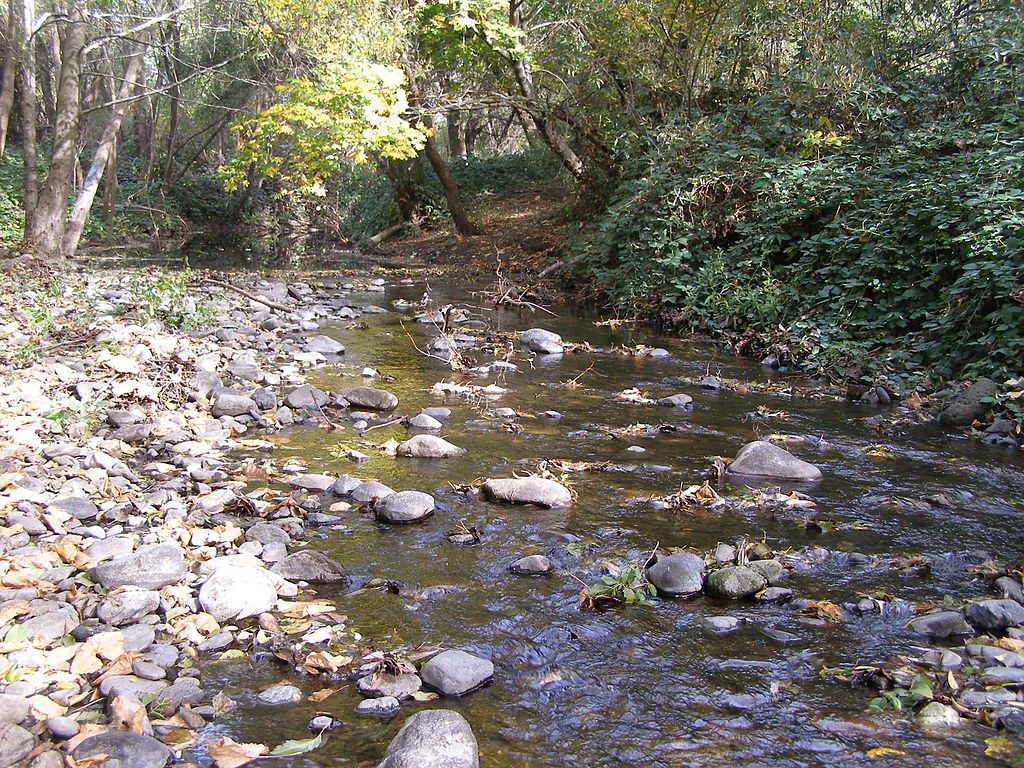
A Time of Disorder
We in this country are taught to believe that things can more or less go on as they have been. Sure, there is tragedy and misfortune – a job loss, divorce, illness, a death in the family – yet one can grieve and recover and life will resume. Sure there are “natural disasters”, yet help will come, people can rebuild and life will continue.
What happens if, or when, disasters come so fast, from so many directions, that things cannot recover, that “return to normal” becomes a thing of the past? What happens if, or when, disasters falling one on top of another becomes the way of things, the “new normal”?
We tend to expect things to go slowly, in micro-steps, rather than dramatic drops or leaps. Yet when might dramatic drops and leaps become the “new normal”? Are we already there?
How can we live in these kinds of times?
Standing on the creek’s edge, surrounded by ducks and egrets and gently falling leaves, I felt into my bones the necessity of living each day fully and joyfully, walking with beauty, making meaning of every moment, acting and reacting with kindness and compassion.
All this has been said before by many others. Yet in that moment, I let it seep into my bones and spread through my capillaries until my fingertips tingled. The challenge I embraced was knowing, in my core, that I would have to live these values in what might become a constant state of unsettledness and upheaval.
Yet this was not all – there was something more.
How could I (and we) not only maintain our balance and equilibrium, live fully and meaningfully, in times of escalating upheaval – beyond this, how much can we save and protect in these times; and how can we gently guide the next generations as they move into a more turbulent future?
I was reminded of these words, from Bertold Brecht’s poem, To the Next Generation:
I came to the towns in a time of disorder,
when hunger was the order of the day…
I ate my bread between the battles.
I lay me down to sleep with murder all about…
That is how I would spend the time which was given to me on Earth.
Berkeley Firefighters and the Line of Sorrow
A couple of weeks after the fire, my husband showed me a YouTube video made by firemen from Berkeley as they drove into the fire, not knowing what they would find. You hear a fireman softly whisper “Oh, my God!” as they enter Santa Rosa and realize the fire is so much bigger than they expected.
When they arrive at the Kmart parking lot that they had been told was to be their staging ground, the 100,000 square foot building was already fully in flame. Heading west, they drive through the already burned Coffey Park neighborhood. “It looks like a bomb went off,” a firefighter says.
They continue driving, searching for something they can save. “There must be houses at some point that are still salvageable,” says one. Finally they find a street dividing burned houses from homes that were not yet burned – and get to work.
On that morning, they saved 30 houses. They “drew a line” and stopped a fire that just happened to be heading in the general direction of my home. Who can say, and count, the ripple effect of the homes and lives that they saved.
The firefighters called the place between what was saved and lost, “The Line of Sorrow”. Perhaps we will all be called to work in the space between what is already lost and what can still be saved in these increasingly tumultuous times. Perhaps each of us, and all of us together, must learn to walk our personal and communal “Line of Sorrow”.
These firemen drove straight into a firestorm that was much larger than they expected. Once there, they looked around for something they could save – and set to work saving it.
We live in the age of the Anthropocene, a firestorm that is likely to be so much larger than we expected. How can we, in an analogous way, find our own “Line of Sorrow” and work to save what can be saved?
Dianne Monroe is a Life Mentor, Experiential Educator, writer and photographer, living in Santa Rosa, CA. She offers programs and personal mentoring using a blend of arts, creativity and nature connection practices to support people in finding soul path and purpose, knowing their deepest life story for this world, navigating times of transition and more. Visit her website (www.diannemonroe.come), email her ([email protected]) or read more of her articles (http://www.diannemonroe.com/articlesinterviews).
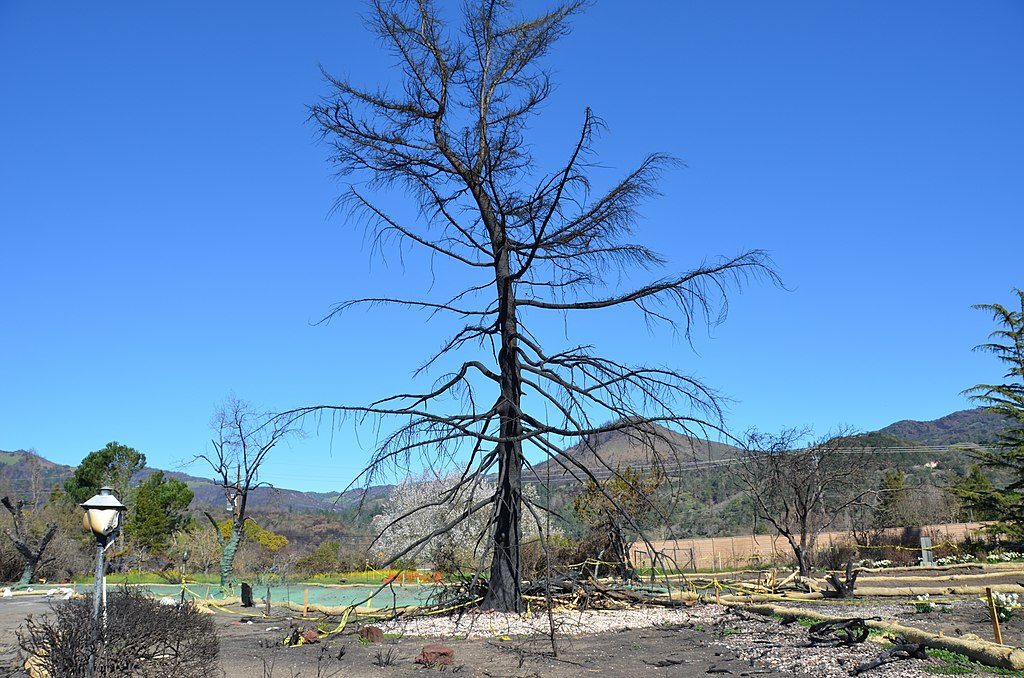
anthropocene California wildfires Carr Fire Dianne Monroe fire recovery Kincade Fire Santa Rosa Tubbs Fire wildfire